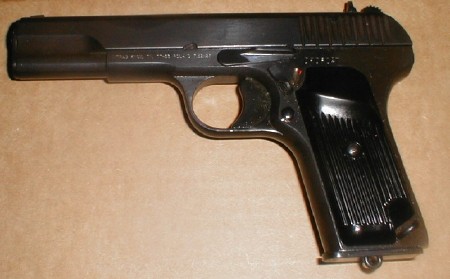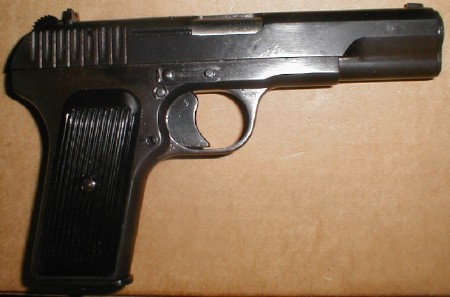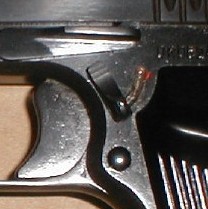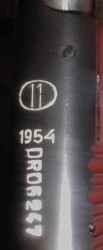 |
Polish M48 (Tokarev TT-33) Pistols |  |
|
|
|
|
CRUFFLER.COM
presents
FIREARM
REVIEW,
March 2001:
 |
Polish M48 (Tokarev TT-33) Pistols |  |
 |
Type:
Single Action Self Loading Pistol
Caliber: 7.62x25mm Capacity: 8 round box magazine Sights, front: Fixed Blade Sights, rear: Tangent U-notch adjustable for windage Length: 7.68" Barrel length: 4.57" Weight (unloaded): 29 ozs Suggested Retail Price: $280 |
Even as the
TT-30 was being put into production, design improvements were engineered.
Production engineers at Tula made minor changes to the design of the trigger,
barrel and frame so as to simplify mass production, the most noticeable
changes being the omission of the removable backstrap (the original trigger
design required the trigger to be pulled out to the rear, hence the removable
backstrap), and the full-circumference barrel locking lugs. The redesigned
pistol was designated the 7.62mm Pistol, M1933, or TT-33, and served as
the Soviet Union's issue sidearm until the late 1950's, when it was
finally supplanted by the Makarov pistol that entered service in 1951.
Significant numbers of TT-33's were produced as can be seen from the production
data below:
|
|
|
|
|
|
|
|
|
|
|
|
|
|
|
|
|
|
|
|
|
|
|
|
As noted above, the Tokarev pistols were based upon the Colt-Browning design and used a swinging link beneath the barrel to unlock the barrel from the slide on recoil. Some minor modifications were made with the intention of simplifying manufacture and maintenance: One such feature was the ability to remove the lockwork en bloc from the frame for cleaning and maintenance. Another modification was the machining of the magazine guide lips into the frame itself, ensuring reliable function even if the magazine lips were out of specification or damaged. Another interesting feature was the lack of a manual safety. There is a half cock notch that locks the slide in the forward position, but no other safety mechanism is fitted.
After the Second
World War, the TT-33 became the standard service pistol of the Warsaw Pact
armies, and was manufactured in several Soviet client states. In
Poland, Hungary and Yugoslavia, locally produced TT-33's were known as
the M48. A Yugoslav version chambered for the 9mm Parabellum was
designated the M65. Communist Chinese variants were known as the
M51 and the M54, while the North Korean Tokarevs were called the M68.
PRODUCT
REVIEW
INTRAC of
Knoxville, Tennessee is now importing Polish M48 Tokarevs produced at the
Radom factory in Poland between 1952 and 1956. The pistols are being
sold by Southern Ohio Gun
(SOG) of Lebanon, Ohio. The guns were advertised as being in "excellent"
condition, with the purchaser's choice of one or two matching magazines
(for an additional fee), and as we're suckers for Second World War pattern
service pistols (even if produced after the war), we called up SOG and
ordered one. A day or two later, the BBT
arrived, bearing our Tokarev.
External Inspection

Polish M48 as imported by INTRAC (Note safety spindle behind trigger) |
As noted,
the advertisements claimed the Polish Tokarevs to be in "Excellent" condition.
This was certainly not the case with the specimen we received. Instead
of being excellent, as can be seen from the accompanying photographs, the
gun was brand-spanking-new. Neither the barrel nor the breech face
displayed any sign of even a single round having been fired. The
bluing was perfect, with not a single scratch or blemish. The barrel,
which was left in the white was in comparable condition. The bore
was bright as a mirror, with sharp, high rifling.
Once we recovered from the happy shock of the gun's external condition, two concessions to US import restrictions became immediately apparent. |
| mounted on the upper rear left corner of the frame, a la M1911A1. The modification was usually done in a manner evidencing haste and a greater concern for manufacturing costs than aesthetics or function. The safety on the Intrac import we received was done by a Polish armory prior to export and departs from this paradigm in all ways. It is mounted on the left side of the frame directly behind the trigger, below the slide stop, and above the magazine release. It pivots in a hole bored through the frame on a spindle that runs through the frame and is secured on the right side with a c-clip. The safety's ball detent moves in and is retained by an arc-shaped groove milled into the frame. The safety lever itself is teardrop shaped, nicely knurled on the flats, and blued to match the gun. Operationally it is |

M48 Retrofitted Safety |

M48 Slide Top |
The other apparent modification are the grips. They are of black plastic, and lack the five pointed escutcheon of the originals. Additionally, the left hand grip panel features a thumb rest and is relieved for the safety. While the original grips can be retrofitted, the safety will not operate if they are installed. Markings included serial number on the frame above the left grip panel, on the left side of the chamber area of the barrel and on the top of the slide. Additionally, the lockwork mechanism and many small parts were also serial numbered. All serial numbers matched. The top of the slide also bore production date and factory markings. The postwar, communist-era name for the Radom Arms Factory was "Factory Number Eleven," and weapons produced at this facility during that time will bear a circled eleven on or near the chamber area. |
Shooting
the M48 Tokarev
We have to
admit to a certain amount of trepidation prior to taking the M48 to the
range. It's a relatively light, slim pistol, and the 7.62x25mm cartridge
is no slouch when it comes to recoil or muzzle velocity. The combination
of the two had a good potential to make this a rather unpleasant gun to
shoot. Despite these fears we packed up and headed out to the NRA
range in Fairfax, Virginia.
Ammunition
We brought
along two types of 7.62x25mm ammunition with which to test the M48:
South African
RSA "New Generation" 86 grain FMJ (this is remanufactured "range" ammunition)
Czechoslovakian
Military 86 grain FMJ
Accuracy
We fired the
M48 at twenty one, thirty, and forty-five feet. Target was a three
inch black center. Accuracy was quite serviceable, with the New Generation
turning in the best results. Our best efforts were: One ragged
hole measuring about an inch at twenty one feet, an inch and a half cluster
thirty feet, and approximately two and a quarter inches at forty-five feet.
Results with the Czech ammunition were somewhat less stellar, with at least
one "flyer" per group, and the overall results being very inconsistent.
Sight regulation was very good at all ranges with the mean point of impact
and the point of aim coinciding nicely. Given the combination of
a forty-seven year old pistol, fixed sights, ammunition of unknown provenance,
and our meager abilities, we were well pleased. We believe that the
accuracy would improve significantly if the trigger were somewhat lighter.
Recoil and
Ergonomics
Recoil was,
well, surprising. Given the pistol's comparatively slim lines and
light weight coupled with the powerful 7.62x25mm cartridge, we expected
recoil to be both heavy and potentially unpleasant. This was happily
not the case. In fact, the recoil sensation was about the same as
that of a Browning High Power with standard 9x19mm loads, and less than
that of a Glock 19 or 17. The Tokarev was far more comfortable to
shoot than Vz-52 in the same chambering. We attributed this to the
shape of the butt and the Browning tilting barrel design. Muzzle
flip was apparent but not extreme, and when using a two handed hold, we
were able to bring the gun back onto the target very quickly for follow
up shots.
Ergonomically, the M48 is a very comfortable gun to hold. Its rounded contours and slim grip offer attractions to both large and small handed shooters. The large handed shooter will find that the gun seats easily in the hand, that the grip is natural and readily repeatable, and that the well designed grip tang provides ample protection from slide bite. The small handed shooter will be well pleased with the slim grip frame that makes the pistol easy to hold. The thumb swell grip, while not original, was very comfortable.
The sights provide a clear, easily acquired picture. While ostensibly following the same notch/blade design paradigm of other pistols of that era, the rear notch is larger than one would expect, and squared at the bottom instead of notched. As a result the sights present a more "modern" appearance than one would expect. Now if they'd only put white dots on them. . .
The safety is effective, but not particularly easy to use, and showed some roughness of manufacture - there was a little difficulty in getting it to move within its prescribed arc of motion and a pronounced grittiness. We believe that this will smooth out with use.
The only blemish
on what was otherwise an ergonomically excellent pistol was the trigger.
Unloaded, the pistol displayed a somewhat heavy, but very crisp trigger
pull. Initially, this was borne out when firing. However, as
firing continued, the pull became harder and harder, until it was an effort
to fire the gun. We're not sure as to the cause of this phenomenon,
but it may be attributable to the added safety. On the other hand,
it's certainly not something that would have impeded the M48's combat effectiveness;
one seldom fires three hundred rounds of pistol ammunition in two hours
in combat, and the adrenaline surge associated with having people shooting
at you would certainly have overcome a slightly recalcitrant trigger.
Nevertheless, the trigger does make the M48 unappealing for casual target
work.
Reliability
We fired two
hundred rounds each of the Czech ammunition and the South African ammunition.
No failures to feed, fire, extract, or eject were noted.
Conclusion
This latest
Tokarev offering is one of the best in terms of overall condition that
we've seen on these guns in a long time. The added safety is well
thought out, and decently executed, even it it does need a little smoothing.
While the import stamp and the safety lower the gun's collectibility, the
two matching numbered magazines are a nice touch toward that end.
From a historical and "representative sample" perspectives, these M48's
represent a great boon. However, they would not be our first choice
in a defensive sidearm or a "working" pistol. Nevertheless, they
are relatively inexpensive, very nicely made and finished, and perfect
for that gap in your collection between the Soviet M1895 Nagant revolver
and the East German Makarov pistol.
And now, our
Buy-O-Meter rating for the M48:
 |